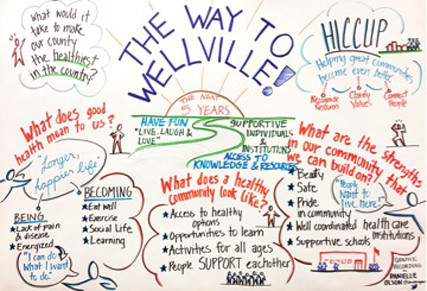 Graphic recording of community response to questions about what would make a healthier county; recorded at the Way to Wellville town hall in the city of Seaside, Clatsop County Oregon, January 2015. (Image courtesy of Danielle Olson)
Graphic recording of community response to questions about what would make a healthier county; recorded at the Way to Wellville town hall in the city of Seaside, Clatsop County Oregon, January 2015. (Image courtesy of Danielle Olson)
I am a social worker with more than 20 years of experience working in different communities and am now involved in helping a health care payer engage with communities. I have always tried to understand “where people are at” and build from there, and at a recent meeting hosted by the Institute of Medicine (IOM), titled “Designing Evaluations for What Communities Value,” I realized that my instinctual way of working and the approaches I bring to the health sector from my social work background map to theories on how communities operate.
For example, taking the time to speak in depth with individuals to understand their needs falls under the formally developed approach of narrative methodology. The process of considering how people’s many different affiliations affect their actions and decisions is closely related to theories and approaches about systems thinking—the idea that multiple things can influence multiple things within a system. Realizing this connection between the practices social workers use, and the theoretical work that informs and strengthens those practices, has helped me think through how my organization can further support the communities we serve to improve health outcomes outside of the clinical setting.

I work for Columbia Pacific Coordinated Care Organization (CPCCO), a nonprofit health care plan for Medicaid-enrolled individuals and families in three counties of northwest Oregon. A coordinated care organization (CCO) enables people to get all of their care—physical, behavioral, or dental—through the same plan, which includes things like transportation to health services, disease prevention, and help managing chronic health issues. The overall idea is to create more-integrated care and engage the community in the improvement of health.
CPCCO works with communities through community advisory councils. There is one per county, and members reflect the diversity of each county’s community. The council mandates that 51 percent of the membership must be currently enrolled in Medicaid; the other 49 percent either work closely with people enrolled in Medicaid or reside in a community served by CPCCO. My job involves coordinating these councils, ensuring community engagement, and developing community health partnerships outside of the clinical setting. All three community councils report to a regional one.
CPCCO believes that eliciting the voices of the community and meeting them “where they are at” is critical to improving health outcomes. Working this way acknowledges that 90 percent of factors that influence our health occur outside the clinical setting. In 2013, we conducted a community health assessment in each county. The information from the assessments helped inform the process of choosing three health priorities to focus on, across the region, over the next five years. As part of the community health assessment CPCCO created a survey that asked residents’ opinions of the health and health care needs of the communities in which they live—and then discussed the results with each of the affiliated community advisory councils. We also presented the data to the regional advisory council, which prioritized three areas to address over the following three years: obesity, mental health, and substance abuse.
Meanwhile, we piloted a narrative methodology approach provided by Cognitive Edge, in which participants—prompted with a question—share a story and then give the story a title. After that, the moderator asks each person a series of other questions that measure the effect their story has had on their life. The idea is that, in effect, the participant rates the importance of the story, rather than a researcher.
This approach aims to help everyone—citizens and providers of care—find a deeper understanding of how communities perceive themselves—in our case, how they see health and health care needs. We used it to understand more about the challenges people face in trying to be healthy, and the types of collaborative programs or activities that we could undertake to positively impact health in the communities we serve.
Using this approach made me realize that I have always used a narrative methodology—I just never called it that. Although my work has been largely clinical, I have been collecting stories (narratives) for a long time with the goal of understanding what people need from social services.
This narrative methodology approach is also powerful because community members formulate all of the questions. Making the approach participatory engages community members in both the collection and interpretation of the narratives to find solutions.
We found that the narratives we collected provided a rich context that we didn’t get from the community survey, and that there are many reasons why conditions or problems exist. This enabled us to see new patterns and explore more potential solutions. People’s actions and decision-making processes are flexible, and depend on ever-changing internal and external circumstances; they are continuous works-in-progress. The narratives also helped us see that a small action to address an issue can have a big effect—something much harder to glean from our survey data.
Using the Cognitive Edge approach was also my first exposure to systems thinking. I have always understood individuals as a collection of affiliations: cultural, religious, geographic, familial, professional, etc. Each of these affiliations influence individuals—both their development and behavior, and the choices they make with regard to their health. It made me realize that we need to embrace systems thinking to create strategies that resonate with individuals.
Another “aha!” moment I had at the IOM meeting—alongside narrative methodologies and systems thinking—came with my introduction to collective impact, the idea that a group of actors from different sectors can create a common agenda to solve a specific social problem. I am now using all three of these big-picture theories to help me think through how we might do more for our communities. Understanding that these theories not only exist, but also align with my instinctual way of working gives me great confidence and furthers my resolve to improve health outcomes at the community level.
Support SSIR’s coverage of cross-sector solutions to global challenges.
Help us further the reach of innovative ideas. Donate today.
Read more stories by Nancy Knopf.

